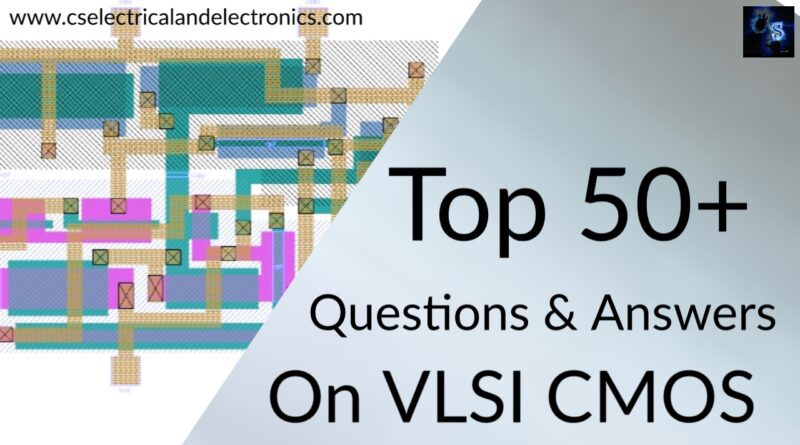Top 50+ Interview Questions And Answers On VLSI CMOS Circuits
Hello guys, welcome back to my blog. In this article, I will discuss the top 50+ interview questions and answers on VLSI CMOS circuits, interview questions on VLSI, VLSI interview questions, etc.
If you have any doubts related to electrical, electronics, and computer science, then ask question. You can also catch me @ Instagram – Chetan Shidling.
Also, read:
- Top 16 Highest Paying Engineering Jobs in the USA For Freshers
- How Chips Are Made Or Manufactured, How Integrated Circuit Are Formed
- Top 20 VLSI & Embedded Systems Projects for Mtech Students
Top 50+ Interview Questions And Answers On VLSI CMOS Circuits
Here are the top 20 Interview Questions & Answers on VLSI Cmos:
01. Why Are Mosfets Used Instead Of Bjts In Today’s Vlsi Circuits?
A. MOSFETs, in comparison to BJTs, may be manufactured very small since they occupy a small silicon space on an IC chip and are relatively simple to manufacture. Furthermore, circuits that employ only MOSFETs, i.e. no resistors, diodes, or other components, can be used to create digital and memory ICs.
02. What Are Mosfet’s Different Operating Regions? What Are the Functions of Those Regions?
A. The cut-off area, the triode region, and the saturation region are the three operating regions of a MOSFET. To work as a switch, the cut-off region and the triode region are used. The saturation area is employed as amplification.
03. What Is Threshold Voltage and How Does It Work?
A. The threshold voltage is defined as the voltage between Gate and Source (VGS) at which a sufficient number of mobile electrons aggregate in the channel region to produce a conducting channel (Vt is positive for NMOS and negative for PMOS).
04. What Does “The Channel Has Been Pinched Off” Mean?
A. When VGS is larger than Vt, a channel is induced in a MOSFET. As VDS rises, current begins to flow from Drain to Source (triode region). When we increase VDS to the point where the voltage between the gate and the channel at the drain end equals Vt, i.e. VGS – VDS = Vt, the channel depth at the drain end reduces to practically zero, and the channel is said to be pinched off. This is the point at which a MOSFET reaches saturation.
05. What Is Channel-length Modulation and How Does It Work?
A. When VDS is increased beyond the saturation point, it affects the MOSFET’s properties in practice. The channel pinch-off point moves away from the Drain and towards the Source as VDS is increased. As a result, the effective channel length shortens, a process known as Channel Length Modulation.
06. Explanation of the Depletion Region?
A. When a positive voltage is supplied across Gate, free holes (positive charge) are repelled from the substrate region beneath the Gate (the channel region). When these pores are driven down the substrate, a carrier-depletion region is left behind.
07. What are the several factors that influence the threshold voltage?
A. It is determined by the voltage applied to the Body terminal, as stated in the previous question. It also relies on the temperature; for every 1oC increase in temperature, the amplitude of Vt reduces by around 2mV.
08. What Role Do Tie-High And Tie-Low Cells Play?
A. Using either the power or the ground, tie-high and tie-low are utilized to link the transistors of the gate. The gates are connected to the power or ground, and the power bounce from the ground allows them to be turned off and on.
09. What Is Chain Reordering’s Purpose?
A. Due to the congestion generated by the positioning of the cells, the chain ordering system finds it difficult to route due to the optimization technique applied. Some tools automate the reordering of the chain to decrease the congestion caused by the first stage.
10. What Is An Enhancement Mode Transistor And What Does It Do?
A. Because they rely on the electric field to change the shape and conductivity of the channel, enhancement mode transistors are also known as field-effect transistors. In a semiconductor material environment, this consists of one sort of charge carrier.
11. What Does It Mean To Have A Depletion Mode Device?
A. Depletion modes are employed in MOSFETs, which are devices that stay on even when the gate-source voltage is zero. Load resistors are utilized in logic circuits, and this gadget contains them. This kind is employed in N-type depletion-load devices that allow for the measurement of threshold voltages and the use of -3 V to +3V.
12. What Are Tie-High And Tie-Low Cells, And How Do They Work?
A. The gate of the transistor is connected to either power or ground using tie-high and tie-low cells. If the gate is coupled to power or ground in deep submicron processes, the transistor may be turned on or off owing to power or ground bounce.
13. What Is The Difference Between Latches And Flip-Flops?
A. Flip-flops are edge sensitive, while latches are level sensitive. The difference between latch and flop design is that latch allows time borrowing, whereas a traditional flop does not. As a result, latch-based design becomes more efficient.
14. What Do the Terms “Local-skew,” “Global-skew,” and “Useful-skew” Mean?
A. The disparity between the clock reaching the launching flop and the clock reaching the destination flip-flop of a timing path is known as local skew.
For the same clock domain, global skew is the difference between the earliest reaching flip-flop and the latest reaching flip-flop. Useful skew is a notion that involves delaying the capturing flip-flop clock path to meet setup requirements in the launch and capture timing paths.
15. Why is it that the number of gate inputs to CMOS gates is often limited to four?
A. The gate will be slower as the amount of stacks increases. The number of gates in the stack of NOR and NAND gates is usually the same as the number of inputs plus one. As a result, the number of inputs is limited to four.
16. What exactly is a multiplexer?
A. A multiplexer is a circuit that selects one of several input signals and sends it to the single output.
17. What does SCR (Silicon Controlled Rectifier) stand for?
A. The SCR is a four-layered solid-state device that regulates the current flow. It’s a form of rectifier that uses a logical gate signal to control it. It’s a three-terminal gadget with four layers.
18. What exactly is Slack?
A. A time delay disparity between the expected and actual delay in a given path is referred to as slack. Slack can be both positive and unpleasant.
19. What distinguishes Verilog from other programming languages?
A. Verilog differs from other programming languages in the following ways.
- Concept of simulation time
- Several threads
- Primitive gates and network links are basic circuit ideas.
20. What exactly is Verilog?
A. The HDL (Hardware Description Language) Verilog is used to describe electronic circuits and systems. Circuit components are prepared inside a Module in Verilog. It includes behavioral as well as structural statements.
21. Difference between analog layout and digital layout design?
22. What is fanin dependent delay?
23. What is the worst case propagation delay?
24. Difference between TTL and CMOS?
25. What is twin-tub process in CMOS VLSI?
26. What is p-well process in CMOS VLSI?
27. What is design rule check (DRC) in CMOS VLSI?
28. What is Intrinsic delay of the gate?
31. What is Elmore delay in CMOS VLSI?
32. What is standard gate capacitance in CMOS VLSI?
33. What is sheet resistance in CMOS VLSI?
34. What is high to low transition in CMOS VLSI?
35. What are the limitation of Dynamic CMOS logic?
36. What are the objectives for Euler path and Stick Diagrams?
37. What is the worst case propagation delay of the circuit?
38. What is tpLH and tpHL in CMOS VLSI circuits?
39. What is Rise time in CMOS VLSI circuits?
40. With a neat diagram, explain the various timing parameters of a CMOS circuit?
41. What is dynamic logic design?
42. What is static logic design?
43. UV Lithography is used for?
44. What is the primary motivation for replacing planar MOSFETs with FinFETs?
45. What is stick diagram in CMOS?
46. What is fullform of ASIC is?
48. Which MOS is controlled in P-well, N-well and twin-tub process in fabrication?
49. Discuss the recent trends in fabrication technology?
50. Why P-sub is preferred over N-sub? Give reason.
This was about ” Top 50+ Interview Questions And Answers On VLSI CMOS Circuits”. I hope this article “Top 50+ Interview Questions And Answers On VLSI CMOS Circuits” may help you all a lot. Thank you for reading “Top 50+ Interview Questions And Answers On VLSI CMOS Circuits”.
Also, read:
- 100 + Electrical Engineering Projects For Students, Engineers
- 1000+ Electronics Projects For Engineers, Diploma, MTech Students
- 1000+ MATLAB Simulink Projects For MTech, Engineering Students
- 500+ Embedded System Projects For Engineer, Diploma, MTech, PhD
- 500+ Projects For Diploma Electrical, Electronics Student, Diploma Project
- 8051 Microcontroller Timers, TCON Register, TMOD Register
- Advancements In 3D Printing Technology And It’s Future
- Advancements In Power Electronics For Energy Efficiency
Author Profile
- Chetu
- Interest's ~ Engineering | Entrepreneurship | Politics | History | Travelling | Content Writing | Technology | Cooking
Latest entries
 All PostsApril 19, 2024What Is Vector CANoe Tool, Why It Is Used In The Automotive Industry
All PostsApril 19, 2024What Is Vector CANoe Tool, Why It Is Used In The Automotive Industry All PostsApril 13, 2024What Is TCM, Transmission Control Module, Working, Purpose,
All PostsApril 13, 2024What Is TCM, Transmission Control Module, Working, Purpose, All PostsApril 12, 2024Top 100 HiL hardware in loop Interview Questions With Answers For Engineers
All PostsApril 12, 2024Top 100 HiL hardware in loop Interview Questions With Answers For Engineers All PostsMarch 22, 2024Driver Monitoring Systems In Vehicles, Working, Driver Sleepy Alert
All PostsMarch 22, 2024Driver Monitoring Systems In Vehicles, Working, Driver Sleepy Alert








